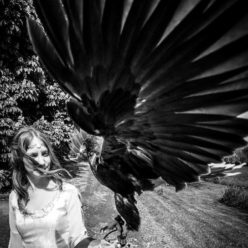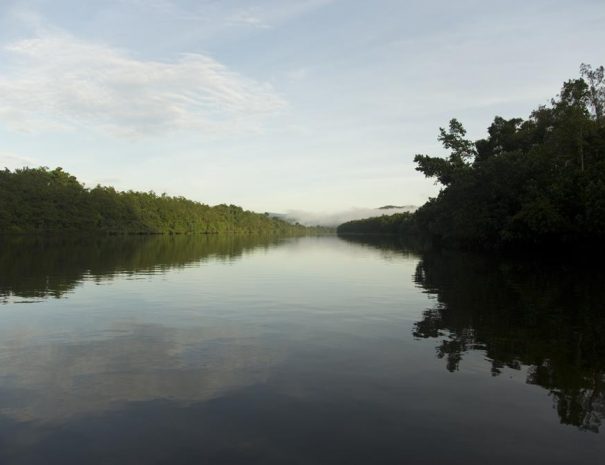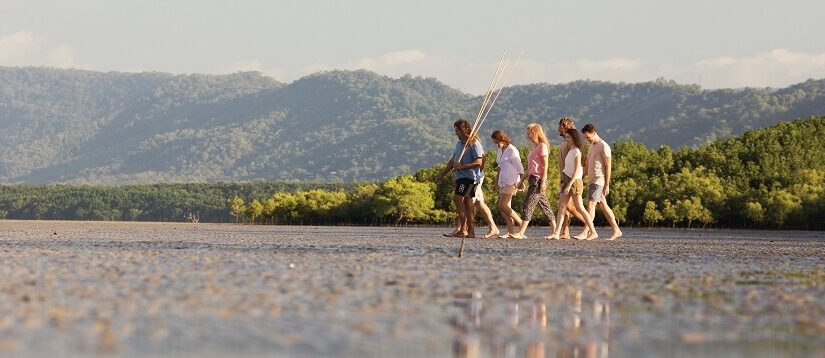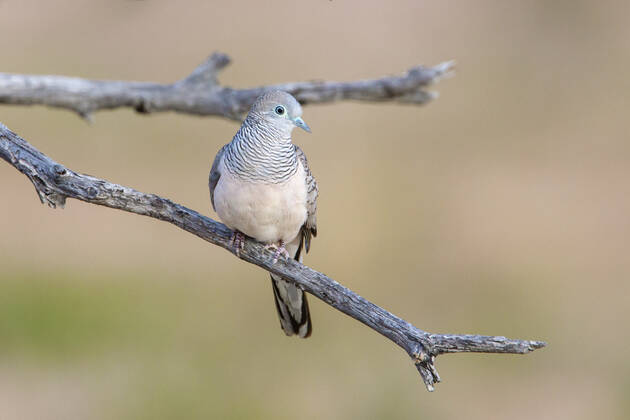The joy of the Kimberley is wilderness. That is why people go. Our little troop, loud on port and gin often disturbed the peace and quiet so I didn’t get my bird-geek on, but trees and flowers are not frightened of general carousing. Boabs were a wonderful discovery. I’ve seen images of these, often in paintings, or they are described in poems and stories where someone is sat in their shade, but despite their hype as the truly iconic Proper Australian Tree, they are …pretty ugly. Or so I thought. They are wide and squat in the trunk and often depicted with dead looking branches bare of leaves spread like a crucifix under a punishing sun on the dry, dry, endless red earth. Give me the moist green of a jarrah, or the whimsical fronds of yellow box gums. Not this blasted, bleak thing.
I have been converted. We arrived in Broome at the very start of our trip on a warm night, fragrant with frangipani blossoms (which I thought only existed in Marquez novels), overjoyed to be released from the grip of a Canberra winter into the purple open palm of the Indian ocean and its scented breezes. The first boab I saw was thickset of trunk, curved like an old woman – like an apple, and abundant with leaf. Like a green plume, ornamented with huge, creamy white blossoms frothing with a thousand long stamens. It was beautiful. I have never seen such a friendly looking tree; and friendly they are, being filled with water in the desert. At El Questro, someone has helpfully installed a tap in the trunk of one such tree and the water was pure and clear, and a lot tastier than what came out the tank of our bus. I want you to imagine Terry Pratchett’s Nanny Ogg-made-tree, opening her arms out to hug her children because that is what their wide, wizened, warm and friendly trunks remind me of. The boab nuts which endure long after the leaves (and apparently should NOT be eaten before some serious preparation) hang like Christmas baubles and gifts, reachable between the cleared branches.
As well as the landscape of pink wildflowers, yellow cotton flower and embracing boabs, there is a universe of stars. One of my favourite bits of the trip was going to bed. We have, at last, joined the ranks of Aussies who rave about ‘swags.’ This word is so ingrained in the Australian dialect that they don’t even think to modify it to people like me who think they’re talking about an elaborate curtain arrangement. I have been initiated into the mystery: it is a heavy-duty canvas sleeping bag, for your sleeping bag. There ya go, that’s it. You unroll it, it has a sort of sewn-in foam mattress layer which is comfier than any amount of money spent on blow up/pack down camp mats, you put your sleeping bag inside it, then fight your way through two sets of zips to get in. Exciting for early morning wee urges, useless against mosquitos, hardly lightweight portable, but, you know, if you want to get romantic about it, we could call it a star mat. Because that’s what it’s best for, snuggling in comfortably and watching the universe. On our first night the sky was lit an unreal purple, with the clouds and studs of the milky way tangled up between the branches of a boab glowing silver by the sky. One night after returning from the loo, I watched stars shoot in slow motion; one for up to 8 continuous seconds. What a beautiful way to fall asleep. Another night, I heard dingoes howling. This is less comfortable. I remind you that I am just lying on the ground, face exposed to the nocturnal exploits of wildlife with no walls to divert attraction. What if a dingo nibbles my toes? What if a snake slithers over me? Sleeping on the ground in swags was another thing we would not have done if we had not been with Daddy Damo, and of course, snakes try to avoid big, vibrating things like us.
All this came to a head one night when I saw a croc in the campsite.
Our little camp spot on the well-ordered, well amenitied, boozed up El Questro campsite was right by the river. This is the Pentecost River that Definitely Has Crocs, and after some very scientific finger measuring on the map, the campsite’s location on the river is far less than that all important 100km away from the sea. We unrolled our swags beneath a tree a mere five Yates-Paces (YPs) from the bank itself. I’m sure it’s fine, I said, if they had a pitch where people kept disappearing, we’d know about it. There was a swimming part of the river, with a sort of wall built into it with rocks to protect children from crocs. I refer you above to the bit about crocs crawling up waterfalls and you sure as hell wouldn’t have got me in there. But they’re ambush predators. They don’t sneak out of the water to drag campers off. I’m sure it’s fine. Sure. I slept with memories of brolgas flying into the sunset, the starlight. Then I came back from me midnight wee.
Two little red dots were staring at me from the middle of our camp stool circle.
We’d had a tour of a crocodile sanctuary in Broome and the chap had told us; if you’re camping and you get up for a piss and see little red dots glowing in the dark, those’re freshies. Don’t panic too much, it means the river’s good, you’ll have good fishing, but if they all disappear one night and are replaced by two yellow dots, then get the hell out. Still. Two little red dots more than I wanted to see. Perfect, glowing red dots, and nothing between me and them. I woke up the Gentleman. Dude, get ready to run. We stared in horror together and he stood up for a better look. Three, glowing red dots.
Our campfire was a metal barrel with regular holes drilled in the side along the bottom for air. It was still glowing. Panic over.
Purnululu sounds like a song, doesn’t it? What a lovely word. This was our most remote spot, the campsite was a shed toilet and a tap, defo snakes everywhere I’m sure of it, and the home of unique, layered sandstone beehive shaped rocks. Those that have been to Kata Tjuta’s many heads – it was much like that, you walked through a city of rocks cutting their blades on the blue sky, but they were red and black striped. I wonder if you could learn every rock, every tower, every shape. It was beautiful. These skyscrapers of stone bubble up from the plain in a group, surrounded by smooth, flat land filled with termite mounds and melaleuca. We did some beautiful hikes across the empty Picaninny creek to the look out, then through a maze of flowers to Cathedral gorge and Echidna chasm. Cathedral gorge is the end of a creek where during the wet season a waterfall spills over the top to join the creek and has cut out this huge open cave with pretty amazing acoustics. Greg sang Meatloaf. I sang The Cruel Mother. I don’t know why I chose a sad song. Aren’t the rocks sad? They have watched for so long. Echidna chasm is a thin gap between two walls of red stone, cool and shady, with that same Uluru red AF and blue AF contrasts and finches flitting between the cracks and trees. I write lots of reports commending people who have ‘strategic overview’ who can ‘see the bigger picture.’ We got an expensive 18-minute helicopter ride to see the ‘bigger picture,’ but the lasting joy comes from the close-up details; tufts of tiny white and maroon dry flowers, the stamens of blue petals, the different shades of crimson.
Lake Argyle was the last main stop. Science: this a man-made lake. Insert other info here, about failed agricultural intentions or whatever. For us, this was yet another stretch of water we got in, then out of and then saw crocodiles. Fuck sake. We jumped in the water, we saw freshies up real close; little, short-eared rock wallabies with their joeys on the stones above us and we lazed in the water as the sun went down. Aussies have a cute thing where they chuck a ladder over the side of a boat and lazily announce, pool’s open! I like that. But I really liked being on a boat full of adults shouting, ‘Yeeesss, that one spat at me!!’ There were little archer fish in the water which have great eyesight and will spot crumbs of bread if you hold them out. They use this superpower to spot flies hovering above the water’s meniscus and spit water at them like a missile to bring them down for eating. They’ll do this to bread holding humans, too.
Our final day was in Katherine Gorge, Nitmiluk park’s thousands of bats and Edith falls for one last gorge dunk. This was every bit as lovely as any other gorge, but it was now melancholy with the thought of leaving, of saying goodbye to new friends and sadly recognising that you will not laugh at another of Graham’s puns, or hear another of Greg’s songs, or see another unique pair of boardies from Ben’s inexhaustible wardrobe.
The wonder of travel sometimes, is when it’s over. I’m not sure I really believe this, but I do believe that the important part is reflection and that needs time and sometimes, distance. What images distilled in your mind? What now will be the thing that will pierce you with the briars of nostalgia? It’s the bird geek in me talking, but every day we were chased by the fluted hammer-on call of a bird which now holds in its round notes the heat and smells and yellow flowers of the Kimberley. I was overjoyed when I finally tracked it down in Darwin’s beautiful botanic gardens; a blissful twenty minutes of standing still, listening, looking, moving slowly, and spotting it at last up in the fork of an unromantically spikey tree. I could see its little throat move so I knew that was definitely that ball of feathers making that sound and I could see enough to identify it as ‘something like a pigeon’ so I could start googling doves of the NT and finally call it by its blue-eyed name: peaceful dove. This is why travel is important. You learn about people and things you didn’t even know existed. Another fact I learned that I can’t seem to shake was from our boat guide telling us that Lake Argyle should rise by about 6m every year during the wet season. But repeated drought over the past 8 or so years have replenished it by a mere 30cm a year. Can you imagine that? SIX metres down to 30 centimetres for 8 years. Even this incredible wet season’s efforts of raising the water by an impressive 9m has not brought it back to pre-drought levels. Guide Damo told us that in his 7 years driving people up and down the Gibb River Road, he has never had to swim across Tunnel Creek, and he has no idea what all the wildflowers are called because he’s never seen them before. I hope he sees them again next year and our joy at them wasn’t luck. But increasing drought, and it is caused by increased burning of fossil fuels raising temperatures by over a degree (look, that’s the science, and confirmed by a real geo-paleo…super scientist we had on the tour with us), means those wildflowers might be luck, and those changes are stripping a lot of beauty and colour from the world. And going back to my little peaceful dove, what if they disappear too? This is another reason why travel is important. When you find something new and beautiful, like that blue-eyed, fluting bird, you want to protect it. You’re connected to it, you named it, or held it or touched it, left a bit of yourself with it.
Allowing its death is to permit the death of a bit of you.



